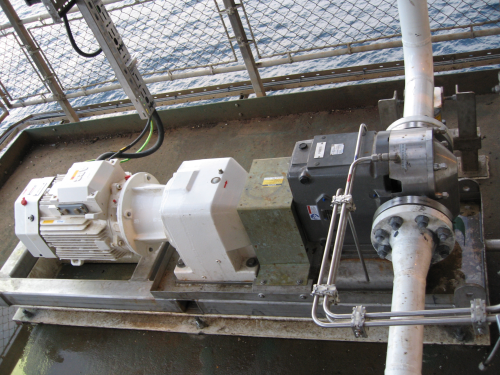
Pumping produced water from closed drain and similar applications is a challenge frequently encountered on offshore platforms. This is because the presence of a high sand content makes the slurry abrasive. However, the problem is compounded by temperatures of approximately 70°C, a varying oil content which affects viscosity, corrosion caused by seawater, NPSHa and chemicals that have a tendency to shorten time intervals between servicing.
For these reasons oil companies need a pump type that is easy to service and provides enhanced lifecycle costs. For many oil companies the pump of choice has become the Waukesha rotary lobe piston pump, which AxFlow has been supplying for a wide variety of applications ranging from liquid gas to heavy crude since 2003. With features including a diamond coating on all wetted parts to give resistance to the abrasive fluid, easy service (typically only 1-2 man hours each time), low NPSHr to handle challenging NPSHa conditions, dry run capabilities, a compact design and low lifecycle cost it is easy to understand why the Waukesha pump is popular.
How the Waukesha rotary lobe piston pump can stand up to the rigours of pumping produced water is best illustrated by AxFlow’s supply of a 4” diamond coated Waukesha 220U2 rotary lobe pump installed on a platform in the North Sea. The Waukesha pump installed was an API676 with deviation and the complete unit was ATEX approved complete with EEXde motor and seal cooling system.
“The previous positive displacement pump employed had eight week service intervals and required a minimum of two man days to change the internal parts,” says Christian Semb, sales manager, AxFlow AS Norway. “Furthermore, the pump gave no indication of the need for servicing before failure and therefore it was difficult to plan ahead to avoid incurring additional costs or down time of the system around the pump.”
Christian Semb continues: “The Waukesha 220U2 rotary lobe pump is capable of giving more than 20 weeks operation between services and the service time is a maximum of one man hour for a rotor change and two hours for a complete housing and seal change. In addition, we can see when servicing is needed because the pump flow is reduced when wear occurs.” Experience reveals that when such a situation occurs, it can be compensated by increasing RPM through a frequency converter to a predetermined maximum frequency, thereby allowing the next service to be planned.
“As a result of switching the Waukesha 220U2 pump for handling produced water, the platform has reduced process costs, reduced downtime and realised predictable service intervals,” says Christian Semb.






